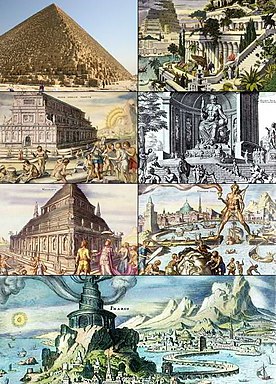Seven Wonders of the Ancient World

The Seven Wonders of the World (or the Seven Wonders of the Ancient World) is a widely known list of seven popular sites of classical antiquity. The list was largely a tourist guide for travelers of the ancient world who wanted to see the most famous and well known sight-seeing destinations.
History
The earliest known version of the list was compiled in the 2nd century BC by Antipater of Sidon; it appears to be based on the guide-books popular among Hellenic sight-seers and only includes works located around the Mediterranean rim where sight-seers could typically travel safely. The Seven Wonders were wonders because they were among the most popular destinations; even as early as 1600 BC, tourist graffiti was scrawled on monuments in the Egyptian Valley of the Kings (by which time the Great Sphinx of Giza was already a thousand years old). It is notable that the Seven Wonders sites were all man-made; no natural features were included since they were not popular destinations. With the industrial revolution's impact on the environment and the resulting naturalism of the Romanticism movement, natural features have become tourist destinations in and of themselves and as such new "Seven Wonders" lists have been created that incorporate natural features.
The Seven Wonders
Listed in order of their construction, the seven wonders are:
| Wonder | Date | Builder | Destroyed | Cause |
|---|---|---|---|---|
| Great Pyramid of Giza | 2550 BC | Egyptians | n/a | n/a |
| Hanging Gardens of Babylon | 600 BC | Babylonians | after 1st century BC | earthquake |
| Temple of Artemis at Ephesus | 550 BC | Lydians, Greeks | 356 BC | fire |
| Statue of Zeus at Olympia | 435 BC | Greeks | 5th-6th centuries AD | fire |
| Mausoleum of Maussollos at Halicarnassus | 351 BC | Carians, Greeks | by 1494 AD | earthquake |
| Colossus of Rhodes | 292-280 BC | Hellenistic Greece | 224 BC | earthquake |
| Lighthouse of Alexandria | 3rd century BC | Hellenistic Egypt | 1303-1480 AD | earthquake |
Antipater's original list replaced the Lighthouse of Alexandria with the Walls of Babylon. It wasn't until the 6th century AD that the list above was used. Of these wonders, the only one that has survived to the present day is the Great Pyramid of Giza. The existence of the Hanging Gardens has not been definitively proven. Records show that the other five wonders were destroyed by natural disasters. The Temple of Artemis and the Statue of Zeus were destroyed by fire, while the Lighthouse of Alexandria, Colossus, and Mausoleum of Maussollos, were destroyed by earthquakes.
More recent lists
In the tradition of the Seven Wonders of the Ancient World, many other lists of wonders have been proposed, including both human feats of engineering and wonders of nature. However, these lists are rather informal, and there is no consensus on any particular list.
See also Seven Wonders of the Medieval Mind
Modern wonders
The American Society of Civil Engineers compiled another list of wonders of the modern world:
- Channel Tunnel
- CN Tower
- Empire State Building
- Golden Gate Bridge
- Itaipu Dam
- Delta Works
- Panama Canal
Tourist travel wonders
The following list of the top seven tourist travel wonders was compiled by Hillman Wonders:[1]
- Great Pyramids of Giza
- Great Wall of China
- Taj Mahal
- Serengeti Migration
- Galapagos
- Grand Canyon
- Machu Picchu
Natural wonders
Similar to the other lists of wonders, there is no consensus on a list of seven natural wonders of the world, as there has been debate over how large the list should be. One of the many lists was compiled by CNN [2]:
- Grand Canyon
- Great Barrier Reef
- Harbor of Rio de Janeiro
- Mount Everest
- Northern Lights
- Paricutín volcano
- Victoria Falls
Underwater wonders
This list of underwater wonders is of unknown origin but has been repeated sufficiently often to acquire a degree of notability:[3] [4]
- Palau
- Belize Barrier Reef
- Great Barrier Reef
- Deep-Sea Vents
- Galapagos Islands
- Lake Baikal
- Northern Red Sea
Notes
See also
External links and references
- Seven Ancient Wonders
- The Seven Wonders of the Ancient World — an in-depth look from a professor of civil engineering at the University of South Florida
- Image of the Seven Wonder locations
- Parkin, Tim, Researching Ancient Wonders: A Research Guide, from the University of Canterbury, New Zealand. - a collection of books and Internet resources with in-depth information on seven ancient wonders.
- Google Maps 7 Ancient Wonders of the World
- Other Wonders
- Official web site for voting new wonders of the World
- The World's Top 100 Wonders - a list of architectural, engineering and natural wonders by Howard Hillman, a renowned travel writer.
- WonderClub.com - a "list of lists", with information about most wonders.
- Seven Wonders of the Modern World - a list of modern wonders compiled by the American Society of Civil Engineers
- Seven Wonders of Chicago - A list compiled by the Chicago Tribune and voted on by residents of the Chicagoland area.
Further reading
- Cox, Reg, and Neil Morris, "The Seven Wonders of the Modern World". Chelsea House Publications: Library. October, 2000. ISBN 0791060489
- Cox, Reg, Neil Morris, and James Field, "The Seven Wonders of the Medieval World". Chelsea House Publications: Library. October, 2000. ISBN 0-7910-6047-0
- D'Epiro, Peter, and Mary Desmond Pinkowish, "What Are the Seven Wonders of the World? and 100 Other Great Cultural Lists". Anchor. December 1, 1998. ISBN 0-385-49062-3
- Morris, Neil, "The Seven Wonders of the Natural World". Chrysalis Books. December 30, 2002. ISBN 1-84138-495-X
